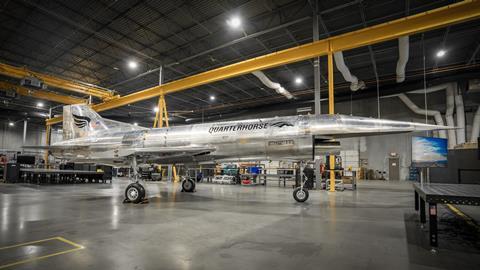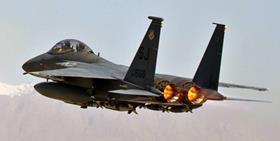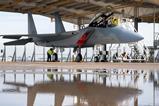US hypersonic developer Hermeus plans to fly its first prototype aircraft this summer.
The Atlanta-based company on 28 March revealed the first images of its first Quarterhorse Mk 1 test vehicle, noting the remotely piloted aircraft will “take to the skies” at Edwards AFB in the coming summer months.
Quarterhorse Mk 1 is the second of four planned variants in the Quarterhorse line. Hermeus used the non-flying Mk 0 version for ground evaluations, which the company completed in late 2023.
With Quarterhorse, Hermeus is seeking to deliver an uncrewed aircraft capable of reaching speeds of Mach 4 and beyond. The company says its target is to break the current airspeed record established by Lockheed Martin’s SR-71 Blackbird nearly 50 years ago.
In 1976, one of the twin-engined Blackbirds reached a velocity of 1,905kt (3,529km/h) – or M3.3, according to the USA’s Smithsonian National Air and Space Museum.

Quarterhorse Mk 1 will not attempt to break the M5 hypersonic barrier – or even the M1 sound barrier. The uncrewed aircraft, which is powered by a single GE Aerospace J85 engine, will instead be used for flight testing at subsonic speeds.
“Its primary mission is to demonstrate high-speed take-off and landing – a key enabling capability unique to future hypersonic aircraft on the company’s roadmap,” Hermeus says.
Integrated flight testing will take place at Edwards AFB, home to the US Air Force’s (USAF’s) 412th Test Wing.
The unit oversees flight testing and evaluation for new USAF aircraft, including the Boeing T-7A jet trainer, which arrived at Edwards last November, and the next-generation Northrop Grumman B-21 stealth bomber, currently undergoing flight testing.

Hermeus is funded in part by investment from the Air Force Research Laboratory’s AFWERX technology accelerator.
While the company has not offered specifics about the Quarterhorse Mk 1 flight test programme, Hermeus says the aircraft will undergo a “battery of tests” in the next several months to prepare for take-off later this year.
“As we begin the journey to first flight, we will conduct a comprehensive evaluation of the aircraft’s performance while simultaneously examining the effectiveness of our test procedures,” says Hermeus vice-president of test, Don Kaderbek.
Two subsequent vehicles – Quarterhorse Mk 2 and Mk 3 – will build upon the information gained during the Mk 1 flight test programme.
The Mk 2 variant will attempt to break the sound barrier and demonstrate autonomous supersonic flight below M3.
Hermeus aims for the final Quarterhorse Mk 3 type to become the “world’s fastest aircraft”, by successfully demonstrating mid-flight transition from a jet turbine to ramjet engine and breaking the SR-71 flight speed record.
At the same time it unveiled the Mk 1, Hermeus also announced its engine selection for the follow-on Quarterhorse Mk 2: Pratt & Whitney’s F100 – best known for powering the Boeing F-15 and Lockheed Martin F-16 fighters.
“The F100 continues to find renewed relevance and we are excited to be a part of Hermeus’ visionary goal of developing platforms that will emulate legendary aircraft like the iconic SR-71,” says Josh Goodman, P&W’s senior director for F100 engines.
First delivered in 1989, there are currently more than 3,800 F100s in service worldwide, according to P&W. The powerplant’s proven record and established supply base were a major draw for Hermeus.
“This upgrade is a huge win for getting a high-performance aircraft into the hands of customers sooner and shows the power of the fast and iterative approach at Hermeus,” says chief operating officer Skyler Shuford.

“By breaking free of rigid, multi-year development timelines, we are enabled to build the right aircraft for this moment and get that aircraft in the air in less than a year,” he adds.
Rapid progression through aircraft development and fabrication is a pillar of the Hermeus strategy.
The company says Quarterhorse Mk 0 was designed and built in under six months. The process took just seven months for the Mk 1 vehicle.
The Mk 2 aircraft is apparently not far behind, with Hermeus claiming the third Quarterhorse variant will “fly at supersonic speeds next year”, in a 28 March post on LinkedIn.
Shuford argues “an enormous amount” of programmatic risk is reduced by focusing on the rapid succession of each aircraft in the development pipeline.
Chief executive AJ Piplica calls that approach the most important aspect of the Hermeus strategy, citing the rapid progression – and commercial success – of orbital rockets and small uncrewed air vehicles in recent years.
“We’re now bringing that power of iteration speed to aircraft,” he says. “It’s a capability that is absolutely necessary for solving the challenges of operationalising hypersonic aircraft.”
Longer-term, Hermeus plans to develop a “high-Mach drone” and a multi-mission hypersonic vehicle called Darkhorse, which will be tailored for defence and national security applications.



















































